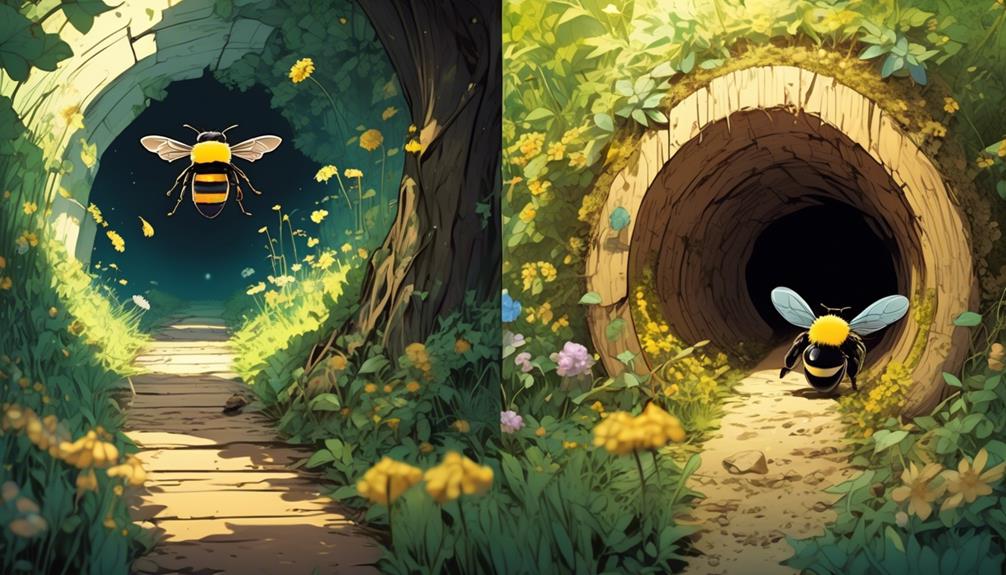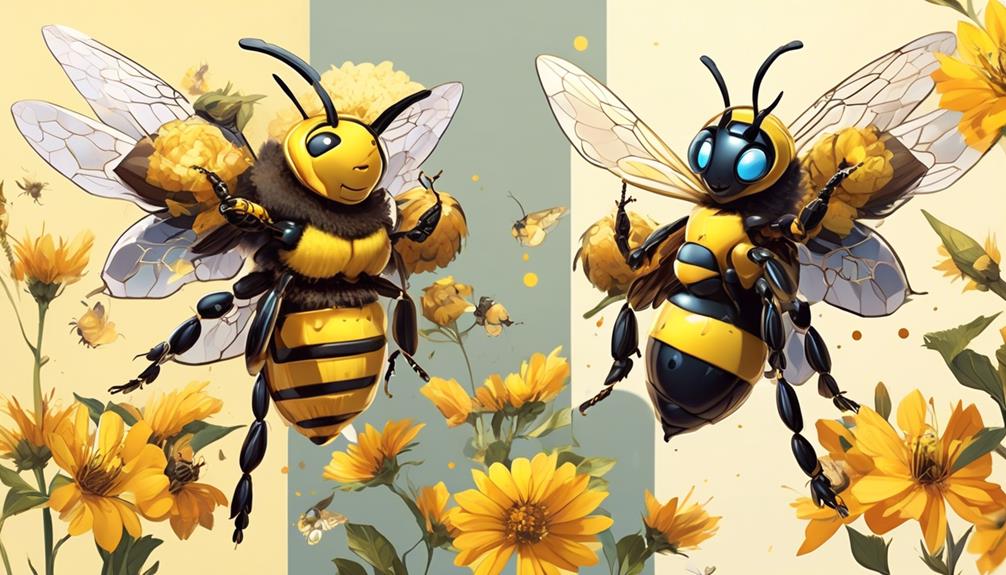Cracking the code between Carpenter Bees and Bumblebees may surprise you; discover their intriguing differences and why they matter to our ecosystem.

Carpenter Bees Vs Bumblebees
Did you know that there are over 20,000 known species of bees worldwide?
Yet, when it comes to Carpenter bees and Bumblebees, the distinctions often blur in the eyes of many. You might think they're practically identical, but that's where you'd be wrong.
While both these bees share similar sizes and some common behaviors, their physical characteristics, habitats, and impacts on the ecosystem vary significantly.
So let's embark on a journey to unlock the mysteries that make each of these bees unique in their own right, and why understanding these differences matters to you.
Key Takeaways
- Carpenter bees and bumblebees are both important pollinators in the ecosystem.
- Carpenter bees are solitary and do not live in hives, while bumblebees are social insects that live in colonies.
- Carpenter bees prefer habitats with abundant dead wood, while bumblebees are adaptable and can make nests in various places.
- Carpenter bees may cause damage to wooden structures over time, while bumblebee stings can be a threat to humans, especially those with allergies.
Understanding Carpenter Bees

Let's delve into understanding carpenter bees, a species known for their unique wood-boring behaviors that sets them apart in the realm of bee species. Unlike most bees, carpenter bees are solitary. They don't live in hives; instead, you'll find them in wood, where they bore holes to create nests. They're distinguishable by their size, larger than most bees, and their shiny, black abdomen, setting them apart from their fuzzier counterparts.
Male carpenter bees can't sting, but they're territorial. If you get close, they might buzz around you, trying to ward you off. Females can sting, but they're less aggressive unless provoked.
Carpenter bees play a crucial role in pollination. While they're known as “nectar thieves” because they cut holes in plants to access nectar without pollinating, they still contribute significantly to pollination when collecting pollen for their offspring.
However, their wood-boring activity can cause substantial damage to wooden structures over time. They prefer softwood, like pine or cedar, which is often used in homes, decks, and furniture. The damage isn't immediate, but it's cumulative, and if you don't manage it, it can get quite severe.
Key Characteristics of Bumblebees

Shifting our focus from the solitary, wood-boring carpenter bees, we now turn our attention to their fuzzier counterparts, the bumblebees, a species that brings its own unique set of characteristics to the table. Unlike the carpenter bees, bumblebees are social insects that live in colonies. They're robust, larger than their carpenter bee counterparts, and have distinctive bands of black and yellow.
To help you visualize, let's look at a simple table:
Feature | Bumblebees |
|---|---|
Size | Large |
Body | Robust, fuzzy |
Color | Black and yellow bands |
Social Structure | Colonial |
Bumblebees are known for their buzzing sound, produced by their fast-moving muscles and not their wings. They are also vital pollinators and can fly in cooler temperatures and lower light levels than many other bees, thanks to their large size. It's their distinctive banding pattern, however, that truly sets them apart. Each specie has a unique combination of black and yellow bands, making them easily identifiable. So, next time you're out in your garden, you'll be better equipped to spot these fuzzy visitors.
Habitats and Lifestyles Explored

In exploring the diverse habitats and lifestyles of both carpenter bees and bumblebees, you'll find remarkable adaptations that allow these species to thrive in their respective environments.
Carpenter bees are solitary creatures. They prefer habitats with abundant dead wood, bamboo, or structural timbers where they can bore tunnels for their nests. This solitary lifestyle puts a premium on their ability to forage independently for pollen and nectar.
On the other hand, bumblebees are social insects, living in colonies ranging from 50 to 400 individuals. They're adaptable and can make their nests in a variety of places, from underground burrows to grass tussocks or even bird boxes. These bees exhibit a division of labor, with a queen bee laying eggs and worker bees performing tasks like foraging and maintenance.
The lifestyle differences between these two bee species are intriguing. For instance, you'll find that carpenter bees' solitary nature leads them to be less aggressive unless their nests are threatened. In contrast, the social structure of bumblebees may lead to more defensive behavior to protect their colony.
Each species' adaptation to their lifestyle and habitat is a testament to nature's incredible diversity and resilience.
Physical Differences Outlined

Having explored their differing lifestyles and habitats, we can now turn our attention to the physical distinctions that set carpenter bees apart from bumblebees. First, let's examine size. While both species can vary, typically, carpenter bees are larger, often exceeding an inch in length, whereas bumblebees usually measure between half an inch to an inch.
The coloration is another crucial difference. The body of a carpenter bee is mostly black and shiny, with a metallic sheen, while bumblebees display black and yellow stripes, resulting in a fuzzy appearance. You'll notice that carpenter bees lack the hairiness that bumblebees have, especially on their abdomen.
Your attention should also be directed towards their wings. Bumblebees have a slight amber tint on their wings, while carpenter bees have dark, almost black wings.
Lastly, the sex of the bee can be identified by observing the head. Male carpenter bees have a white or yellow face, while female carpenter bees and bumblebees of both sexes have a black face.
Through these physical traits, you can distinguish between these two bee species. Each difference not only aids in identification but also plays a role in their survival strategies and ecological roles.
Impact on Ecosystem and Humans

Ever wondered about the role these buzzing creatures play in our ecosystem and how they impact human life? Both carpenter bees and bumblebees are crucial pollinators. They transfer pollen from male to female parts of flowers, facilitating plant reproduction. Imagine walking through your favorite garden without the vibrant diversity of flowers, or opening your pantry to find a reduced variety of fruits and vegetables. That's the world without these industrious insects.
Carpenter bees, despite their reputation for boring into wood, are solitary pollinators, focusing on individual plants and flowers. They're particularly good at pollinating open-faced flowers. They might be a nuisance to your wooden structures, but they're a blessing to your garden.
On the other hand, bumblebees, with their larger bodies, are capable of buzz pollination. By vibrating at a specific frequency, they shake pollen loose from flowers, contributing to the pollination of crops like tomatoes and blueberries.
However, their stings can be a threat to humans, especially those with allergies. Yet, they typically sting only when threatened. So, if you leave them to their vital ecological role, they'll likely leave you in peace. These bees, despite their differences, play pivotal roles in our ecosystem and impact human life significantly.
Conclusion
So, you've explored the world of carpenter bees and bumblebees. While they share a similar look, they've got distinct lifestyles and habitats.
Carpenter bees are solitary, wood-boring creatures, whereas bumblebees thrive in social colonies. They both play crucial roles in our ecosystem, aiding in pollination.
However, carpenter bees can be a nuisance to homeowners. Understanding these differences can help you coexist peacefully with these buzzing neighbors or tackle any unwelcome carpenter bee invasions.


